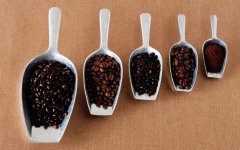Vietnam fine coffee beans Vietnam cat shit coffee?
According to the statistics of Vietnam Coffee Association, in 2000-2001 (from October 2000 to September 2001), Vietnam exported 874676 tons of coffee from 149 enterprises, among which the three largest exporters were OLAM Company (foreign-owned enterprise, 21326 tons), DAKMAN Company (joint venture, 18076 tons) and Vinafimex Company (local enterprise, 13719 tons).
The Vietnamese Coffee Quality Standards Committee was led by the Vietnamese Coffee Association to draft Vietnamese coffee standards, which were submitted to the Ministry of Science, Technology and Environment (now the Ministry of Science and Technology) for approval by the Vietnamese General Bureau of Standards and Quality Monitoring. [3]
process edition
Vietnamese coffee (Figure 3)
Vietnamese coffee (Figure 3)
In the field of coffee processing, Vietnam has only had some dilapidated processing plants since 1975, and there are several processing plants in the north, such as Tongjiao and Fukui, whose equipment was manufactured in East Germany between 1960 and 1962. In the south, the old factories left behind by former manor owners such as ROSSI, DELPHANTE, etc. are also small in scale. While expanding the coffee planting area, Vietnam also began to build new coffee processing plants, initially manufacturing some single equipment, and later copying production lines according to HANGXA model. The main manufacturers are Haiphong 51 Machinery Factory and A74 Factory of the Ministry of Industry in Sau Duc, Ho Chi Minh City. In recent years, more and more companies and farms imported equipment from Germany and Brazil to build more complete new processing plants, imported more than a dozen sets of Brazilian Pinhalense coffee processing production lines. Later, some factories began to imitate Brazilian equipment and improve their own production. In recent years, Vietnam's coffee processing capacity has been greatly improved, and it can guarantee the export of 150,000 to 200,000 tons of coffee kernels every year. In addition, there are many enterprises with insufficient equipment, which only process with a few single machines and purchase coffee that has been initially processed from farmers in order to ensure export standards. Coffee purchased from the private sector is mainly distributed by farmers through cement or soil drying. In many places farmers use small grinders to grind dried coffee into coffee kernels, which they sell to coffee buyers. This process leads to unstable product quality. The coffee produced by each company and farm is usually of good quality and beautiful appearance, such as the companies of Dole: victory (thang loi), phuoc an (phuoc an), viet duc (viet duc), buon ho (buon ho), delao (d dao), etc., which are affirmed by customers. Generally speaking, coffee sales have not been carried out according to national standards for a long time, and the quality provisions in the sales contract are very simple, which are only determined by the buyer and the seller through consultation, which fails to effectively promote the improvement of coffee quality and processing industry level.

Important Notice :
前街咖啡 FrontStreet Coffee has moved to new addredd:
FrontStreet Coffee Address: 315,Donghua East Road,GuangZhou
Tel:020 38364473
- Prev

Cappuccino Cappuccino, Italian foam coffee Italian mix coffee beans Brazil raw beans
First of all, we have to see what the purpose of Espresso coffee is. We say that if any kind of coffee appears in the form of a single product, it has the characteristics, that is, it has both advantages and limitations in taste. The purpose of the combination of Espresso is to express the taste of the baker. In other words, the taste of Espresso coffee is designed by the roaster. In order to make
- Next

Mocha "Chocolate" Coffee beans, Chocolate Coffee Italian, hand-made.
First of all, we have to see what the purpose of Espresso coffee is. We say that if any kind of coffee appears in the form of a single product, it has the characteristics, that is, it has both advantages and limitations in taste. The purpose of the combination of Espresso is to express the taste of the baker. In other words, the taste of Espresso coffee is designed by the roaster. In order to make
Related
- Detailed explanation of Jadeite planting Land in Panamanian Jadeite Manor introduction to the grading system of Jadeite competitive bidding, Red bid, Green bid and Rose Summer
- Story of Coffee planting in Brenka region of Costa Rica Stonehenge Manor anaerobic heavy honey treatment of flavor mouth
- What's on the barrel of Blue Mountain Coffee beans?
- Can American coffee also pull flowers? How to use hot American style to pull out a good-looking pattern?
- Can you make a cold extract with coffee beans? What is the right proportion for cold-extracted coffee formula?
- Indonesian PWN Gold Mandrine Coffee Origin Features Flavor How to Chong? Mandolin coffee is American.
- A brief introduction to the flavor characteristics of Brazilian yellow bourbon coffee beans
- What is the effect of different water quality on the flavor of cold-extracted coffee? What kind of water is best for brewing coffee?
- Why do you think of Rose Summer whenever you mention Panamanian coffee?
- Introduction to the characteristics of authentic blue mountain coffee bean producing areas? What is the CIB Coffee Authority in Jamaica?

